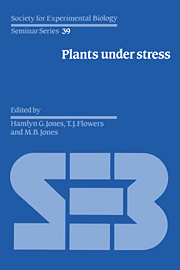Book contents
- Frontmatter
- Contents
- Contributors
- Preface
- 1 Introduction: some terminology and common mechanisms
- 2 The impact of environmental stresses on ecosystems
- 3 Whole-plant responses to stress in natural and agricultural systems
- 4 Photosynthesis and gas exchange
- 5 Regulation of growth and development of plants growing with a restricted supply of water
- 6 Stresses, membranes and cell walls
- 7 Desiccation injury, anhydrobiosis and survival
- 8 Molecular biology: application to studies of stress tolerance
- 9 Environmental control of gene expression and stress proteins in plants
- 10 Plant tissue and protoplast culture: applications to stress physiology and biochemistry
- 11 Breeding methods for drought resistance
- 12 Selection for physiological characters – examples from breeding for salt tolerance
- 13 Prospects for improving crop production in stressful environments
- Index
5 - Regulation of growth and development of plants growing with a restricted supply of water
Published online by Cambridge University Press: 16 March 2010
- Frontmatter
- Contents
- Contributors
- Preface
- 1 Introduction: some terminology and common mechanisms
- 2 The impact of environmental stresses on ecosystems
- 3 Whole-plant responses to stress in natural and agricultural systems
- 4 Photosynthesis and gas exchange
- 5 Regulation of growth and development of plants growing with a restricted supply of water
- 6 Stresses, membranes and cell walls
- 7 Desiccation injury, anhydrobiosis and survival
- 8 Molecular biology: application to studies of stress tolerance
- 9 Environmental control of gene expression and stress proteins in plants
- 10 Plant tissue and protoplast culture: applications to stress physiology and biochemistry
- 11 Breeding methods for drought resistance
- 12 Selection for physiological characters – examples from breeding for salt tolerance
- 13 Prospects for improving crop production in stressful environments
- Index
Summary
Introduction
On a global basis, drought limits plant growth and crop productivity more than any other single environmental factor (Boyer, 1982). Even in Britain, rain-free periods are frequent enough for irrigation to lead to yield advantages for many agricultural and horticultural crops. Water supply is restricted in many parts of the world and productivity in these environments can only be increased by the development of crops that are well adapted to dry conditions. It is clear that the potential for biotechnological improvement of crop performance cannot be realised until we have identified genes and gene products which are responsible for the desired characteristics of drought tolerance. This in turn cannot occur without a thorough understanding of the biophysical, biochemical and physiological perturbations that are induced by a restricted water supply.
Although plant growth rates are generally reduced when soil water supply is limited, shoot growth is often more inhibited than root growth and in some cases the absolute root biomass of plants in drying soil may increase relative to that of well-watered controls (Sharp & Davies, 1979; Malik, Dhankar & Turner, 1979). It is also commonly observed (e.g. Sharp & Davies, 1985) that the roots of unwatered plants grow deeper into the soil than roots of plants that are watered regularly. Clearly, increases in the density and depth of rooting can help sustain a high rate of water extraction in drying soil (Sharp & Davies, 1985) and may promote substantial improvement in yield in dry years (Jordan, Dugas & Shouse, 1983).
- Type
- Chapter
- Information
- Plants under StressBiochemistry, Physiology and Ecology and their Application to Plant Improvement, pp. 71 - 94Publisher: Cambridge University PressPrint publication year: 1989
- 75
- Cited by

